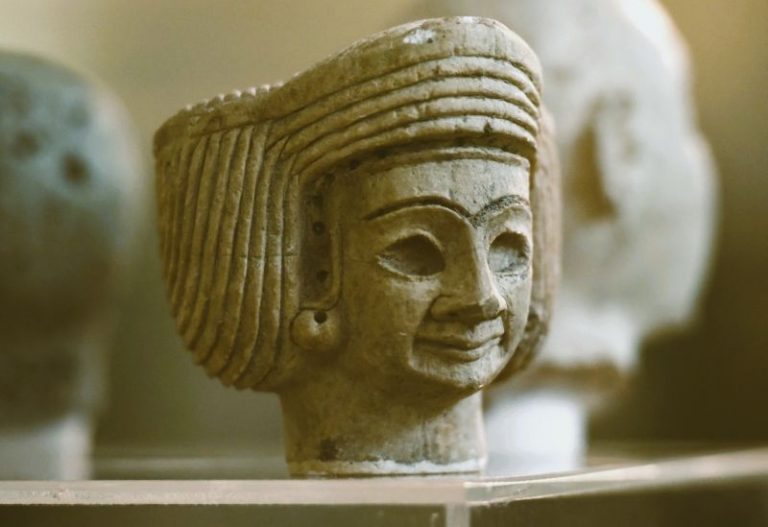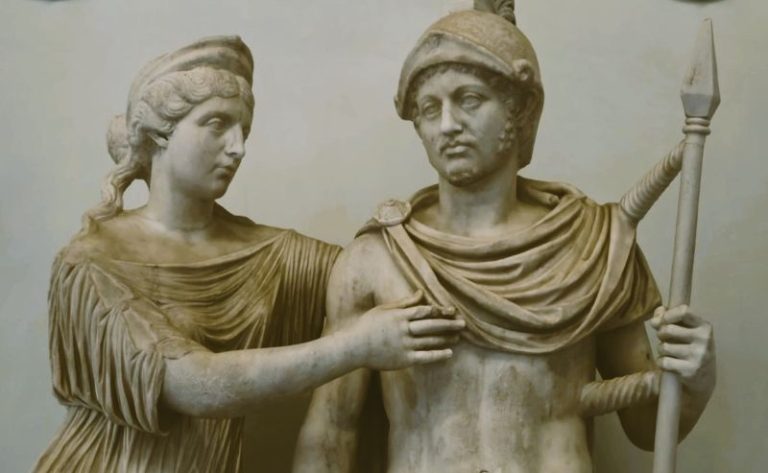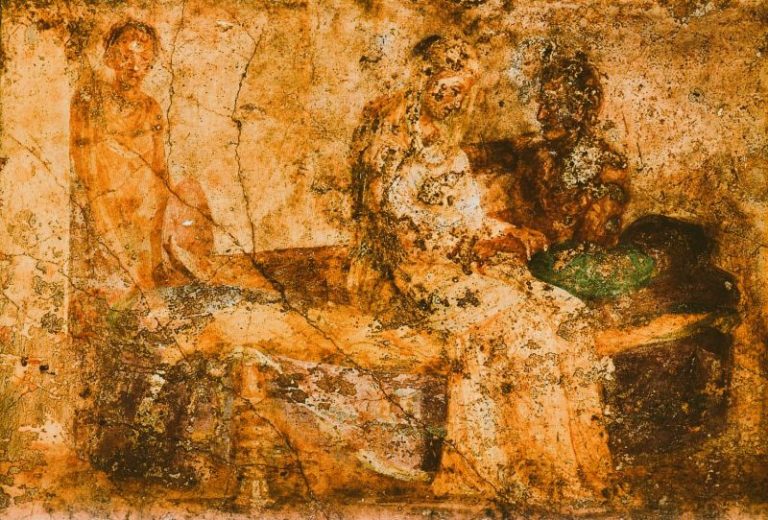
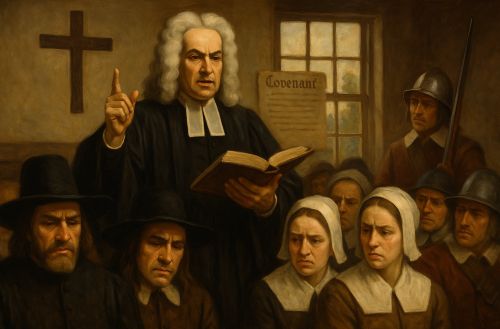
The Massachusetts Bay Colony remains one of history’s most striking attempts to fuse politics and religion into a single theocratic order.

By Matthew A. McIntosh
Public Historian
Brewminate
Introduction
The Massachusetts Bay Colony has long stood as one of the most vivid experiments in religious governance in the early modern Atlantic world. Founded by English Puritans in the 1630s, the colony sought to embody a covenant with God through its political and social institutions. What emerged was not a secular polity but a Christian commonwealth in which civic authority was inseparable from religious duty. Into this environment was born Cotton Mather, grandson of Richard Mather and son of Increase Mather, two of the colony’s most prominent ministers. Cotton inherited both their legacy and their contradictions: he became a defender of Puritan theocracy while also grappling with the changing intellectual and political currents of the late seventeenth century. His career illuminates both the power and the fragility of theocratic governance in colonial New England.
The Foundations of Theocracy in Massachusetts Bay
“A City Upon a Hill”: Covenant as Political Blueprint

Puritan political thought was anchored in covenant theology. The colonists understood themselves as bound to God in a collective covenant, much like ancient Israel. Their migration to New England was framed as a sacred mission, a chance to establish a “city upon a hill” that would model godly order for the world.1 This covenant required strict adherence to divine law, and the breach of communal morality was regarded not merely as a private failing but as a threat to the colony’s collective relationship with God.
Thus, governance was imagined not as a negotiation of secular interests but as the enforcement of sacred obligations. The magistrates of Massachusetts Bay ruled with an eye not only to civic peace but to the maintenance of covenantal purity. In this sense, political authority was indistinguishable from religious authority.
Law as Gospel: Institutions of Divine Authority
The institutional arrangements of the colony reflected these theological commitments. Only those who had undergone conversion and been admitted as church members could vote or hold office. Ministers, though not formally magistrates, wielded immense influence, advising governors and shaping the spiritual direction of the community.2 The General Court combined legislative, executive, and judicial functions under the mantle of divine authority.
This fusion produced a society in which the line between church and state was porous at best. Civil laws codified religious prohibitions, from blasphemy to Sabbath-breaking, while sermons doubled as political commentary. The Massachusetts Bay Colony was thus less a secular state than a visible church writ large.
Cotton Mather’s Inheritance and Formation
Born to Rule the Pulpit: A Family of Theocrats
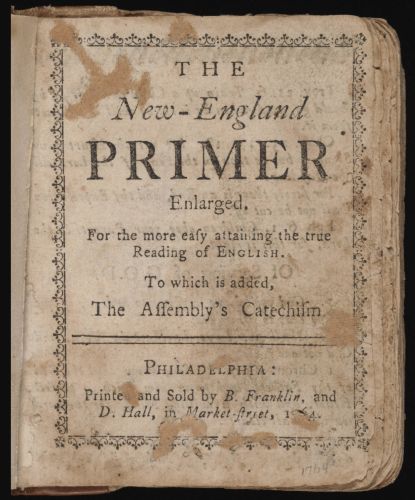
Cotton Mather was born into the very heart of this Puritan establishment. His grandfather, Richard Mather, had been a principal architect of the colony’s congregational system, while his father, Increase Mather, served as both minister of Boston’s North Church and as a political negotiator with the English crown.3 This lineage provided Cotton with both access and expectation: he was destined to be a guardian of the colony’s religious and political experiment.
From an early age, Mather demonstrated intellectual precocity. He entered Harvard College at just twelve years old, training for the ministry under the tutelage of the colony’s foremost theologians. His education combined classical learning with rigorous scriptural study, preparing him to defend the Puritan worldview in both pulpit and print.
Providence and Purity: A Theology of Control
Mather’s theology was deeply providential. He interpreted historical events through the lens of divine judgment and mercy, seeing in every plague, war, or storm a message from God to His covenant people. For Mather, crises were not random but providential summons to repentance and reform. His writings reinforced this outlook, blending theology with social commentary.4
At the same time, Mather emphasized the necessity of maintaining the visible purity of the church. He inherited the Puritan suspicion of dissent and innovation, insisting that the survival of the colony depended on fidelity to its founding covenant. His theology thus provided intellectual scaffolding for the theocratic structures he defended.
Mather as Defender of Theocracy
The Pen as Sword: Mather’s Prolific Defense of Order

Mather’s career as a minister and author made him the leading defender of the Puritan establishment in the late seventeenth century. He published hundreds of works, ranging from sermons to histories to theological treatises. In each, he underscored the divine mandate of Massachusetts and the dangers of spiritual laxity.
Crises were interpreted as divine chastisements. Epidemics were warnings against moral corruption, wars with Indigenous peoples were punishments for backsliding, and political turmoil was evidence of God’s displeasure. For Mather, the proper response was not reform of institutions but stricter adherence to divine law.5 His rhetoric reinforced the idea that obedience to rulers was inseparable from obedience to God.
Specters and Trials: Salem as Theocracy’s Crucible
The Salem witch trials of 1692 marked the most infamous episode of theocratic enforcement in New England, and Cotton Mather’s role was central. Though he did not preside over the trials, his book Wonders of the Invisible World provided theological justification for the proceedings. He defended the use of spectral evidence, insisted on the reality of diabolical plots, and argued that the colony was under siege by Satanic forces.6
Mather’s defense of the trials revealed both the power and the peril of theocratic reasoning. By treating witchcraft as a cosmic battle between God and Satan, he gave legitimacy to extraordinary judicial measures. Yet when the trials ended in discredit, his reputation suffered, illustrating the dangers of aligning clerical authority too closely with state coercion.
Cracks in the Theocracy
Heresy and Dissent: Fault Lines from Within

From its earliest years, Massachusetts Bay faced challenges to its theocratic model. Figures such as Roger Williams and Anne Hutchinson had already exposed the limits of Puritan toleration by the 1630s. Quakers continued to press against Massachusetts’ religious exclusivity, often at the cost of imprisonment or execution. By the later seventeenth century, demographic growth, increased trade, and exposure to broader Atlantic currents diluted the cohesion of the original covenantal vision.7
These pressures made theocratic enforcement increasingly difficult. As the colony grew more diverse and economically complex, rigid uniformity became less tenable. The ideal of a united community bound by a singular religious covenant was strained, if not broken.
Old Faith, New Currents: Mather’s Uneasy Adaptations
Mather sought to shore up the theocracy even as cracks widened. He called for renewed piety, stricter moral discipline, and vigilance against dissent. Yet he was not entirely inflexible. His defense of smallpox inoculation in the early eighteenth century, though controversial, demonstrated a willingness to integrate new scientific ideas into a providential framework.8 This episode revealed the tensions within Mather himself: he remained a defender of the old covenantal order but could not entirely ignore the intellectual currents reshaping the Atlantic world.
The Paradox of Mather’s Legacy
Scholar and Scold: The Contradictions of a Theocrat
Cotton Mather embodied paradox. He defended rigid orthodoxy yet engaged in scientific inquiry; he condemned dissent yet promoted education and missionary work. His career reflected both the aspirations and the limitations of Puritan theocracy. In him, the effort to preserve covenantal purity clashed with the inevitability of intellectual change.
The Waning of God’s Commonwealth
The 1691 royal charter altered the colony’s governance, broadening religious toleration and curtailing clerical authority. Mather’s influence waned in this new environment. While he remained prolific, the world he defended was passing. Theocratic governance, so central to Massachusetts Bay’s founding vision, could not withstand the pressures of imperial oversight, economic change, and cultural pluralism. Mather thus became both the last great defender of the Puritan theocracy and a symbol of its decline.9
Conclusion: The Last Great Theocrat
Cotton Mather’s life and career illuminate the trajectory of Massachusetts Bay Colony’s theocratic experiment. He was at once heir and defender, theologian and propagandist, scientist and moralist. His writings reveal the enduring power of covenantal theology while also exposing its limitations in the face of social and intellectual transformation.
The Massachusetts Bay Colony remains one of history’s most striking attempts to fuse politics and religion into a single theocratic order. Cotton Mather’s career demonstrates both the intensity of that vision and its ultimate fragility. He represents the paradox of a society that sought to live under divine law yet found itself unable to contain the complexities of human difference and change.
Appendix
Footnotes
- John Winthrop, A Model of Christian Charity, in Collections of the Massachusetts Historical Society, 3rd ser., 7 (1630), 31–48.
- Edmund S. Morgan, The Puritan Dilemma: The Story of John Winthrop (Boston: Little, Brown, 1958), 114–118.
- Kenneth Silverman, The Life and Times of Cotton Mather (New York: Harper & Row, 1984), 9–15.
- Perry Miller, Errand into the Wilderness (Cambridge: Harvard University Press, 1952), 81–86.
- Harry S. Stout, The New England Soul: Preaching and Religious Culture in Colonial New England (New York: Oxford University Press, 1986), 153–160.
- Cotton Mather, Wonders of the Invisible World (Boston: Benjamin Harris, 1693).
- Francis J. Bremer, The Puritan Experiment: New England Society from Bradford to Edwards (Hanover: University Press of New England, 1976), 193–197.
- Silverman, Life and Times of Cotton Mather, 287–291.
- David D. Hall, Worlds of Wonder, Days of Judgment: Popular Religious Belief in Early New England (Cambridge: Harvard University Press, 1989), 212–216.
Bibliography
- Bremer, Francis J. The Puritan Experiment: New England Society from Bradford to Edwards. Hanover: University Press of New England, 1976.
- Hall, David D. Worlds of Wonder, Days of Judgment: Popular Religious Belief in Early New England. Cambridge: Harvard University Press, 1989.
- Mather, Cotton. Wonders of the Invisible World. Boston: Benjamin Harris, 1693.
- Miller, Perry. Errand into the Wilderness. Cambridge: Harvard University Press, 1952.
- Morgan, Edmund S. The Puritan Dilemma: The Story of John Winthrop. Boston: Little, Brown, 1958.
- Silverman, Kenneth. The Life and Times of Cotton Mather. New York: Harper & Row, 1984.
- Stout, Harry S. The New England Soul: Preaching and Religious Culture in Colonial New England. New York: Oxford University Press, 1986.
- Winthrop, John. A Model of Christian Charity. In Collections of the Massachusetts Historical Society, 3rd ser., vol. 7, 31–48. Boston, 1630.
Originally published by Brewminate, 08.29.2025, under the terms of a Creative Commons Attribution-NonCommercial-NoDerivatives 4.0 International license.
